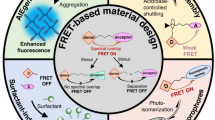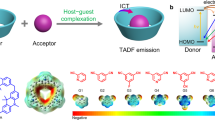Abstract
Xerogels of silica-based organic–inorganic hybrid materials consisting of covalently bound fluorophores, terthiophene and terphenylene derivatives, were fabricated and analyzed. The synthesized chromophore-containing alkoxysilane derivatives were no emission in solid state, but showed strong fluorescence in organic–inorganic hybrid materials as well as in solution. Moreover, the fluorescence quantum yield of chromophore could be further improved in organic–inorganic hybrid materials with the optimized component than that of chromophore dissolved in solution. On the other hand, the fluorescence intensity of hybrid materials decreased with increasing the concentration of chromophore in organic–inorganic hybrid materials. Obviously, the relative distance between chromophores was shortened to perturb radiative relaxation. Temperature-dependent fluorescence spectra revealed that the fluorescence of chromophore in organic–inorganic hybrid materials was temperature-independent. This result indicated the inter-chromophore interactions and intra-molecular motion have been forbidden. The kinetic measurements confirmed that the chromophore spread in organic–inorganic hybrid materials was fixed with rigid conformation. The florescence decay lifetime of chromophore also kept similar at different temperature with organic–inorganic hybrid materials skeleton. This hybrid matrix provided a platform that enhanced fluorescence of chromophore in solid state at ambient temperature.
Graphical Abstract
Emission enhancement of organic chromophores, terthiophene and terphenylene, was performed through the utilization of covalently bound silica-based organic–inorganic hybrid material (OIHM). The chromophore was no emission in solid state, but showed strong fluorescence in OIHM as well as in solution. Moreover, the fluorescence quantum yield of chromophore could be better in OIHM with optimized component than that in solution. Temperature-dependent fluorescence spectra revealed that the fluorescence of chromophore in OIHM was temperature-independent. The kinetic measurements confirmed that the chromophore spread in OIHM was fixed with rigid conformation. This OIHM system offered a useful platform to maintain the emission behavior of organic chromophores in quasi-solid state. 







Similar content being viewed by others
References
May V, Kühn O (2004) Charge and energy transfer dynamics in molecular systems. Wiley-VCH, Weinheim
Klessinger M, Michl J (1994) Excited states and photochemistry of organic molecules. VCH, Weinheim
Chen CH, Liu KY, Sudhakar S, Lim TS, Fann W, Hsu CP, Luh TY (2005) Efficient light harvesting and energy transfer in organic-inorganic hybrid multichromophoric materials. J Phys Chem B 109:17887–17891
Lin CL, Chen CH, Lim TS, Fann W, Luh TY (2008) Combining light harvesting and electron transfer in silica–titania-based organic–inorganic hybrid materials. Chem Asian J 3:578–584
Gomez-Romero P, Sanchez C (2004) Functional hybrid materials. Wiley-VCH, Weinheim
Kwak SY, Kim NR, Lee K, Yi J, Kim JH, Bae BS (2011) Enhancement of fluorescence and lasing properties of covalent bridged fluorescent dye in organic-inorganic hybrid materials. J Sol–Gel Sci Techn 60:137–143
Grando SR, Santos FD, Gallas MR, Costa TMH, Benvenutti EV, Rodembusch FS (2012) Photophysics of aminobenzazole dyes in silica-based hybrid materials. J Sol–Gel Sci Techn 63:235–241
Pletsch D, Santos FD, Rodembusch FS, Stefani V, Campo LF (2012) Bis-silylated terephthalate as a building block precursor for highly fluorescent organic-inorganic hybrid materials. New J Chem 36:2506–2513
Lucenti E, Botta C, Cariati E, Righetto S, Scarpellini M, Tordin E, Ugo R (2013) New organic-inorganic hybrid materials based on perylene diimide-polyhedral oligometric silsesquioxane dyes with reduced quenching of the emission in the solid state. Dyes Pigments 96:748–755
Ohtani N, Tonoi M (2014) Improved photoluminescence lifetime of organic emissive materials embedded in organic-inorganic hybrid thin films fabricated by sol-gel methods using tetraethoxysilane. Mol Cryst Liq Cryst 599:132–138
Liu Y, Yang W, Liu H (2015) Azobenzene-functionalized cage silsesquioxanes as inorganic-organic hybrid, photoresponsive, nanoscale, building blocks. Chem Eur J 21:4731–4738
Modiri S, Mohseni M, Mohajerani E, Kowsari E (2015) Synthesis of organic-inorganic Alq3-based hybrid material by sol-gel method. J Inorg Organomet P 25:680–686
Gom M, Sato K, Tanaka K, Chujo Y (2016) Controllable intramolecular interaction of 3D arranged pi-conjugated luminophores based on a POSS scaffold, leading to highly thermally-stable and emissive materials. RSC Advances 82:78652–78660
Philippo C, Bourdolle A, Maury O, Dubois F, Boury B, Brustlein S, Brasselet S, Andraud C, Ibanez A (2011) Doped silica nanoparticles containing two-photon luminescent Eu(III) complexes for the development of water stable biolabels. J Mater Chem 21:18613–18622
Seo J, Chung JW, Won JE, Park SY (2014) Photoisomeriation-induced gel-to-sol transition and concomitant fluorescence switching in a transparent supramolecular gel of a cyanostilbene derivative. Chem Sci 5:4845–4850
Lin CL, Yeh MY, Chen CH, Sudhakar S, Luo SJ, Hsu YC, Huang CY, Ho KC, Luh TY (2006) Silica-titania-based organic-inorganic hybrid materials for photovoltaic applications. Chem Mater 18:4157–4162
Yang XH, Giovenzana T, Field B, Jabbour GE, Sellinger A (2012) Solution processeable organic-inorganic hybrids based on pyrene functionalized mixed cubic silsesquioxanes as emitters in OLEDs. J Mater Chem 22:12689–12694
Philippot C, Duboi F, Mauri M, Boury B, Prat A, Ibanez A (2012) New core-shell hybrid nanoparticles for biophotonics: fluorescent organic nanocrystals confined in organosilicate spheres. J Mater Chem 22:11370–11378
Kim KH, Park SY (2016) Enhancing light-extraction efficiency of OLEDs with high- and low-refractive-index organic-inorganic hybrid materials. Org Electron 36:103–112
Cho AR, Park SY (2015) Synthesis of titania- and silica-polymer hybrid materials and their application as refractive index-matched layers in touch screens. Opt Mater Express 5:690–703
Daute OJ, Borras C, Borras JD, Moreau JJE (2012) Self-organisation of organosilicas: new approach for the nanostructuration of thin films and the photolithography. Actual Chimique 366:29–35
Cref G, Pichon BP, Blanc C, Maurin D, Sauvajol JL, Carcel C, Moreau JJE, Roy P, Bartlett JR, Man MWC, Bantignies JL (2013) Self-assembly of bridged silsesquioxanes: modulating structural evolution via cooperative covalent and noncovalent interactions. Langmuir 29:5581–5588
Pichon BP, Scampini S, Bied C, Moreau JJE, Man MWC (2012) The influence of arylene and alkylene units on the structuring of urea-based bridged silsesquioxanes. Eur J Inorg Chem 32:5312–5322
Creff G, Arrachart G, Hermet P, Wadepohl H, Almairac R, Maurin D, Sauvajol JL, Carcel C, Moreau JJE, Dieudonne P, Man MWC, Bantignies JL (2012) Investigation on the vibrational and structural properties of a self-structured bridged silsesquioxane. Phys Chem Chem Phys 14:5672–5679
Chemtob A, Ni LL, Croutxe-Barghorn C, Boury B (2014) Ordered hybrids from template-free organosilane self-assembly. Chem Eur J 20:1790–1806
Boury B, Corriu RJP (2003) Auto-organization in sol-gel type polycondensation: a donor to the nanosciences. Chem Rec 3:120–132
Chen CH, Huang YC, Liao WC, Lim TS, Liu KL, Chen IC, Luh TY (2012) Controlling conformations in alternating dialkylsilylene-spaced donor-acceptor copolymers by a cooperative Thorpe-Ingold effect and polymer folding. Chem Eur J 18:334–346
Osuka A, Maruyama K (1988) Synthesis of naphthalene-bridged porphyrin dimers and their orientation-dependent exciton coupling. J Am Chem Soc 110:4454–4456
Matile S, Berova N, Nakanishi K, Fleischhauer J, Woody RW (1996) Structural studies by exciton coupled circular dichroism over a large distance: porphyrin derivatives of steroids, dimeric steroids, and brevetoxin B. J Am Chem Soc 118:5198–5206
Guillet J (1985) Polymer photophysics and photochemistry. Cambridge University Press, Cambridge
Acknowledgements
This work was financially supported by the Ministry of Science and Technology (105-2113-M-035-002-MY2) and Feng Chia University of the Republic of China. We thank Professors Tien-Yau Luh and Tsong-Shin Lim for helping us to synthesize the corresponding monomers and use femto-second laser facilities for kinetic measurements, respectively.
Author information
Authors and Affiliations
Corresponding author
Ethics declarations
Conflict of Interest
The authors declare that they have no conflict of interest.
Electronic supplementary material
Rights and permissions
About this article
Cite this article
Chen, CH., Tsao, YT. Fluorescence enhancement of organic chromophore in solid state via organic–inorganic hybrid matrix: Steady state and kinetic studies. J Sol-Gel Sci Technol 83, 190–196 (2017). https://doi.org/10.1007/s10971-017-4376-1
Received:
Accepted:
Published:
Issue Date:
DOI: https://doi.org/10.1007/s10971-017-4376-1




